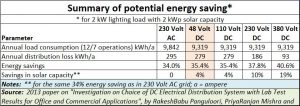Source: http://www.moneycontrol.com/news/business/economy/the-48-volt-dc-power-disruption-to-bring-about-innovation-in-power-consumption-2430533.html
The 48 Volt disruption in power distribution
RN Bhaskar – Nov 06, 2017 03:13 PM IST
In fact some leading players in the power industry have already begun adapting themselves to cope with the coming disruption. But there are others who are unwilling to even consider any change.
There is a major disruption that could be expected in the energy sector.
The falling prices of solar panels — and of batteries as well — are likely propel the industry into experimentation with new techniques. While it would be presumptuous to state that any one select technology will become the chosen mode for power generation, transmission or distribution, one can confidently state that all the three sectors will have to face fierce winds of change, even redundance.
In fact some leading players in the power industry have already begun adapting themselves to cope with the coming disruption. But there are others who are unwilling to even consider any change.
Take, for instance, IS Jha, Chairman & Managing Director of government owned Power Grid Corporation of India. He believes that is no threat to the transmission sector, and that his business plans will therefore remain unaffected.
But ask most other players and they are convinced that a disruption is round the corner.
One such disruption could be the 48 Volt DC module that people in the industry have begun to look at. In fact, the module was a result of research being done in Japan’s laboratories, with research papers being published between 2010 and 2012.
The findings of these papers were intriguing enough to get the Indian Space Research Organisation (ISRO) to consider adopting this module for its ground stations in remote parts of India. It asked some of India’s engineering colleges in Pune to work on pilots on the basis of this technology that the Japanese papers spoke of. The pilots came to an end last year, and ISRO is convinced that this does warrant serious consideration.
The new construct
Japan’s engineers had discovered that using solar power to feed a micro grid using 48 Volt DC (direct current) was an immensely viable alternative to the 22-230 AC standard that most distribution networks (excepting for countries like the US) currently use. In fact, some scientists even recommend the redesigning of networks using the 48 V DC module
But why? The reasons were many. But primary among them were three issues.
- At 48 Volts DC the power transmitted was strong enough to meet the needs of most applications. Some appliances like fans would have to be modified to become brushless fans and could then be run on DC motors.
- Since most electronic appliances use DC power, as do LED lights, there was no sense in converting AC into DC. Even solar power is normally captured as DC, and is then converted to AC to be fed into grids. It would therefore be better to transmit DC power directly. Even when it comes to common desktops, AC power is used only for the SMPS (the fan which is meant to cool the system). The motherboard uses DC. If the SMPS could be dispensed with the AC power input would no longer be required.
- Most crucially, 48 Volts DC is an energy level that the human body can tolerate. It will not cause death.
In fact, ask people at Tata Power, one of the leading players in this field in India. It has implemented this technology in a decentralised manner at some hamlets near its hydropower stations in Maharashtra. Its people will tell you that it is a perfect arrangement for low loss distribution as one doesn’t need to suffer conversion losses as also there is no need to do complex synchronous operations with the grid.
Even the appliances used for this type of setup are cheaper and Tata Power, for instance, has sourced it from vendors who supply lights, fans, refrigerators for railway coaches. And if the hamlet wishes to use fans, the DC version which is brushless is a good substitute – cheaper, more reliable and one which uses less power. Many experts believe that the impact of this concept will be real, though in small, mini, micro grids to supply contiguous areas, much more competitively and reliably.
But why did ISRO choose to go to Pune universities? A good reason was convenience. And Prof Prasad D Khandekar and Prof V M Aranake – who worked on the ISRO pilot – explain, ISRO has a cell on the campus of University of Pune (now called as Savitribai Phule Pune University). It is called the ISRP-UOP Cell. It financially supported this concept and VIIT, Pune completed this funded project last year. And while ISRO has not opted to use this concept for its centres across India, it has begun seriously considering the use of this technology.
According to Professors Khandekar and Aranake, active power savings were in the region of 30 percent; power saving including reactive power was 42 percent; cost of solar plant saving was 30 percent ( as it requires less number of solar panels); there was also a reduction in maintenance cost as no UPS or inverter was required.
The savings achieved by the two professors associated with the project were larger than those detailed by a research team three years earlier. In their paper, the team stated that energy savings were in the region of 35.4 percent and savings in solar capacity were around 4 percent. But with solar prices continuing to fall, it is quite possible that the savings will only multiply as both batteries and solar panels become cheaper.
In fact, some believe that the technology is immediately applicable for rural areas. In fact, Professor Ashok Jhunjhunwala of IIT Chennai has also been promoting this technology. With some tweaking, this technology may get used in urban electrification as well. For instance, Professors Khandekar and Lahane point out how even with a single phase of AC power, using a DC convertor to first convert the single phase power to AC and then reconverted to three phase power, even three phase-powered units like pumps and elevators can be made to run.
The advantages of DC power are just being discovered. It is quite possible that grids will lose some of their relevance especially when it comes to rural power. With new discoveries, catalysed by solar and batteries, it could become relevant for urban households as well.












































COMMENTS